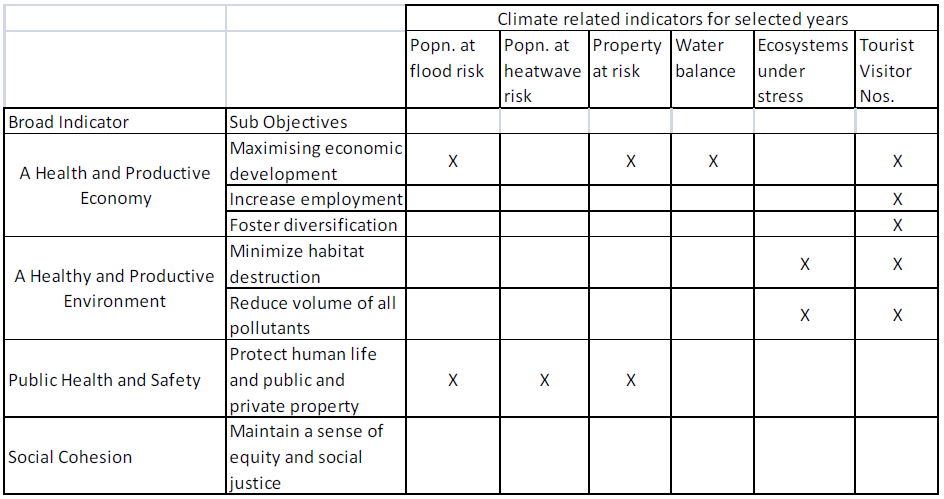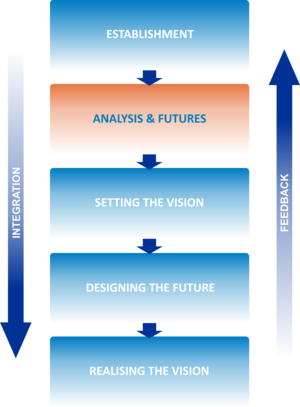Difference between revisions of "Integrating Climate Change into the ICZM planning process - Analysis and Future"
| Line 23: | Line 23: | ||
'''Table 1: Possible climate related Indicators that complement other indicators for the ICZM''' | '''Table 1: Possible climate related Indicators that complement other indicators for the ICZM''' | ||
| − | [[File:Possible climate related Indicators that complement other indicators for the ICZM.png| | + | [[File:Possible climate related Indicators that complement other indicators for the ICZM.png|Possible climate related Indicators that complement other indicators for the ICZM.png]] |
These and other broad estimates of climate impacts in the region are a strong indication of the magnitude of the impacts that need to be taken into account in any future ICZM plans. In doing, however, it is important to avoid duplication of effort and to draw on existing work that has been undertaken at the national, regional and global levels. The best point of departure is the National Communication by the country the UNFCC, which should provide at least national level estimates of the main impacts in terms of temperature increase, sea level rise, precipitation and extreme events. By the very nature of the problem4, such data cannot consist of point estimates, but must be provided in the form of ranges. Thus they will take a form that makes it appropriate to adopt a risk based assessment at future stages of the process. Box 1 provides a description of the kind of data available for a mature economy such as the United Kingdom. Tables 2 and 3 describe the data that is typically provided. Other countries may not have quite the same level of geographical detail; if the impacts are likely to be significant it may be worth asking a specialised agency such as the UK Met Office or the Danish Climate centre to customise projections for specific coastal regions. This is likely to involve some outlays, which may be recoverable from international institutions supporting the preparation of the programme. | These and other broad estimates of climate impacts in the region are a strong indication of the magnitude of the impacts that need to be taken into account in any future ICZM plans. In doing, however, it is important to avoid duplication of effort and to draw on existing work that has been undertaken at the national, regional and global levels. The best point of departure is the National Communication by the country the UNFCC, which should provide at least national level estimates of the main impacts in terms of temperature increase, sea level rise, precipitation and extreme events. By the very nature of the problem4, such data cannot consist of point estimates, but must be provided in the form of ranges. Thus they will take a form that makes it appropriate to adopt a risk based assessment at future stages of the process. Box 1 provides a description of the kind of data available for a mature economy such as the United Kingdom. Tables 2 and 3 describe the data that is typically provided. Other countries may not have quite the same level of geographical detail; if the impacts are likely to be significant it may be worth asking a specialised agency such as the UK Met Office or the Danish Climate centre to customise projections for specific coastal regions. This is likely to involve some outlays, which may be recoverable from international institutions supporting the preparation of the programme. | ||
Revision as of 13:36, 30 October 2013
| Introduction |
|
Establishment |
|
Analysis and Futures |
|
Setting the Vision |
|
Designing the Future |
|
Realising the Vision |
|
Building the evidence
The aim of this stage is to establish an operational foundation for the subsequent preparation of the plan and its implementation. From a climate viewpoint the key tasks are to:
- Identify the main elements of climate variability and change in the short- (10-20 years), mid- (30-40 years), and long-term (60+ years) periods.
- The impacts of this variability on key sectors and the risks associated with them.
The work described below is part of the preparation of the plan, although the strategy should describes the broad structure of the climatic data that needs to be collected and analysed and the tools to be used for this purpose.
Elements of Climate Variability and Change
Increases in average annual temperature at a Mediterranean Basin scale are likely to be slightly higher than at a world level [1] [2]. This increase is estimated at approximately between 2°C and 6.5°C by the end of the century (compared with a global mean increase between 1.1°C and 6.4°C). The probability of temperatures rising by between 3 and 4°C is estimated at 50%.
Table 1: Possible climate related Indicators that complement other indicators for the ICZM

These and other broad estimates of climate impacts in the region are a strong indication of the magnitude of the impacts that need to be taken into account in any future ICZM plans. In doing, however, it is important to avoid duplication of effort and to draw on existing work that has been undertaken at the national, regional and global levels. The best point of departure is the National Communication by the country the UNFCC, which should provide at least national level estimates of the main impacts in terms of temperature increase, sea level rise, precipitation and extreme events. By the very nature of the problem4, such data cannot consist of point estimates, but must be provided in the form of ranges. Thus they will take a form that makes it appropriate to adopt a risk based assessment at future stages of the process. Box 1 provides a description of the kind of data available for a mature economy such as the United Kingdom. Tables 2 and 3 describe the data that is typically provided. Other countries may not have quite the same level of geographical detail; if the impacts are likely to be significant it may be worth asking a specialised agency such as the UK Met Office or the Danish Climate centre to customise projections for specific coastal regions. This is likely to involve some outlays, which may be recoverable from international institutions supporting the preparation of the programme.
References
- ↑ Hallegatte S, Somot S & Nassopoulos H. (2007). Région méditerranéenne et changement climatique: une nécessaire anticipation. Expert report IPEMed.
- ↑ Van Grunderbeeck P & Tourre YM. (2008). Bassin méditerranéen: changement climatique et impacts au cours du XXIème siècle. In: Thibault HL & Quéfélec S. (eds.) Changement climatique et énergie en Méditerranée, 1:1, 1.3-1.69.

